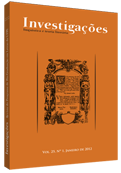Uma mirada interna: centro e periferia em Selva trágica
Abstract
Este artigo tem por finalidade fazer uma análise do texto literário de Selva trágica, de Hernani Donato, particularmente das infl uências culturais que podem ser percebidas na obra, observando como há a imposição de formas de trabalho vindas de um centro, baseado em um capital econômico e, na contramão, há uma resistência dos trabalhadores com relação a essa imposição. Em outros termos, o que se pretende é explorar a relação centro e periferia, dando atenção às estruturas intermediárias que se interpõem nessa relação.References
AGAMBEN, Giorgio. 2007. Profanações. Tradução Selvino José Assman. São Paulo: Boitempo.
AGUIAR, Flavio; VASCONCELOS, Sandra Guardini. 2004. O conceito de transculturação na obra de Ángel Rama. In: ABDALA JÚNIOR, Benjamin. Margens da cultura: mestiçagem, hibridismo & outras misturas. São Paulo: Boitempo.
CARVALHAL, Tânia. 2003. Fronteiras da crítica e crítica das fronteiras. In: – O próprio e o alheio: Ensaios de Literatura comparada. São Leopoldo (RS): Unisinos, p. 153-183.
DONATO, Hernâni. 1995. Selva trágica: a geste ervateira no sulestematogrossense. São Paulo: Autores Reunidos.
FOUCAULT, Michel. 1979. Microfísica do poder. Rio de Janeiro: Graal.
MAGALHÃES, Hilda Gomes Dutra. 2002. Literatura e poder em Mato Grosso. Brasília: MIN; Universidade Federal de Mato Grosso.
PIGLIA, Ricardo. 1991. Memoria y tradición. In: Anais do 2º Congresso Abralic. Belo Horizonte: Fale/UFMG, v.1, p. 60-66.
SAHLINS, Marshall. 2003. Ilha de História. Tradução de Bárbara Sette. Rio de Janeiro: Jorge Zahar.
Downloads
Published
How to Cite
Issue
Section
License
Copyright (c) 2012 Fábio Luiz de Arruda Herrig

This work is licensed under a Creative Commons Attribution 4.0 International License.
Authors who publish with Revista Investigações agree to the following terms:
Authors retain copyright and grant the journal right of first publication with the work simultaneously licensed under the Creative Commons Attribution 4.0 International (CC BY 4.0) license that allows others to share the work with an acknowledgement of the work's authorship and initial publication in this journal.
Authors are able to enter into separate, additional contractual arrangements for the non-exclusive distribution of the journal's published version of the work (e.g., post it to an institutional repository or publish it in a book), with an acknowledgement of its initial publication in this journal.
You are free to:
Share — copy and redistribute the material in any medium or format for any purpose, even commercially.
Adapt — remix, transform, and build upon the material for any purpose, even commercially.
The licensor cannot revoke these freedoms as long as you follow the license terms.
Under the following terms:
Attribution — You must give appropriate credit , provide a link to the license, and indicate if changes were made . You may do so in any reasonable manner, but not in any way that suggests the licensor endorses you or your use.
No additional restrictions — You may not apply legal terms or technological measures that legally restrict others from doing anything the license permits.

